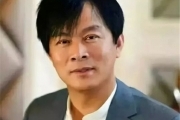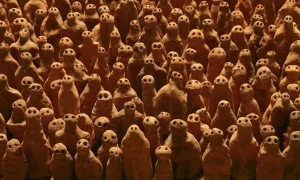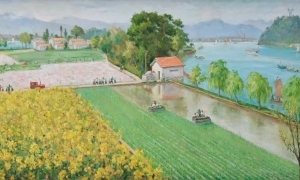芳草地画廊与秦凤玲的合作始于2013年,至今已有两个年头,每一个路过秦凤玲作品的观者,都会驻足画廊细细品味画面。这些漫布堆叠的小人儿散发出的纯真烂漫气息,让画作透露出轻松、抒情、睿智的特质——视觉快乐的背后,却是严峻、残酷和沉重的社会现实。无论从学术意义的角度还是从艺术市场的活跃度出发,秦凤玲的作品都带给芳草地画廊无限的惊喜和希望。此次芳草地画廊很荣幸地邀请到秦凤玲老师,为其举办个人艺术生涯中重要的个展,同时也表达了我们对艺术家给予信任的感谢和对今后长期合作的美好祈愿。
秦凤玲自2005年在画坛初露麟角时,国内外一线策展人、评论家纷纷赞叹这位“self-taught”女性艺术家和她意趣横生的作品。而对大多人来说,秦凤玲这个名字还是模糊的,不发声的,不活跃的,甚至是带有依附性的。她的先生王鲁炎是中国当代艺术重要的引领者之一,人们好像无法不把夫妻二人分开来讲,提到秦凤玲总要谈谈王鲁炎。事实上,王鲁炎和他们的朋友们,的确是秦凤玲艺术生涯的启蒙老师。作为一个没有接受过正统学院式美术基础绘画教育的女性艺术家,她一开始是不拿画笔的。她在朋友聚会时忙于厨房和客厅,做饭泡茶的间隙,听这些优秀评论家、艺术家的热烈讨论。慢慢的,她开始被影响,开始参与讨论,开始有“想说的话、想画的画”。
秦风玲自2005年起,开始多以女人的想像和心绪为题材进行创作,一直关注的社会,一直体验着的生活环境,都是她想跟大家讲话的题材。 “我的画都是凭借我的感觉去画的,不是说画需要什么,而是我想看什么,这就够了”,秦凤玲的画是她的生活日记,是她专属的抒情,画画已经是生活的一部分,不是刻意的,不是一时萌生的,“我觉得我的创作不是一个激情,而是生活中感受的流露,我只关注自己的生活,关注我的周围,关注我要感受的”。你不能依据她的自述就去评判或者断言,秦凤玲是封闭的,是家庭的,是女性的。她的画视野开阔,信息万千,是中国当代绘画谱系的新解构,是“新绘画”最好的诠释。独立性与实验性让秦凤玲在画坛“横空出世”,占有重要的一席之地。
秦凤玲独有的绘画手法是用丙烯颜料制作浮雕小人儿,她将颜料从颜料管中直接挤在画布上,巧妙仔细地塑造成人物形象,它们有眼睛,嘴巴,甚至是神态,迷茫的,呐喊的,张望的,焦急的。我们通过画面可以感受到艺术家与众不同的“说话方式”,她想讲的和我们体验到的,或许一样,或许不一样,画面中的人物状态,或许像我们自己,或许像我们不想变成的人。秦凤玲的作品大多蕴含了对“集体无意识”的概念表达,稠密的人物既与复数和数量相联系,又与个人的集体记忆和经验相关联——儿时的少先队、集体活动、文革的红卫兵组织等。《旗》(2008年)由一组组颜色鲜红、神态微妙的女性微缩人物形象构成。她们如同磁铁般彼此紧挨着,画面传达的理智和情感均揭示了活跃在表面之下的冲动。《城市的间隙-2》(2009年)更是直面了现今社会城市人口密集,交通严重拥塞这一社会聚焦问题,在光鲜斑斓的生活下,人们内心深处散发出的浮躁和不安定,与鲜艳的表象碰击冲撞。秦凤玲也时常巧妙运用比喻、拟人、想象和夸张的方式表现她的绘画内容,在作品《菜虫》(2007年)中,她把爬在大白菜上密密麻麻的虫子拟人化,反馈了艺术家对生活生命的敏感体验;在作品《阶梯》(2009年)中,一架高不可攀的梯子和拥挤在一起争先恐后向上攀爬的人群,隐喻了人对名利与物的无度欲望。是幽默诙谐还是深刻残酷,都是观者自己的体会。
在二十世纪八九十年代,中国进入了突飞猛进飞速发展的新社会,艺术家们也因为社会潮流而深受影响,一系列的特写面部肖像绘画作品接踵而来。纵观中国当代艺术的新“F4”天王,他们的作品都被深深烙上了个人印记。无论是岳敏君作品里标志性的“傻笑”面孔、方力钧极具个性的“光头”人物形象,或是张晓刚“大家庭”和“血缘”系列里人物忧郁的表情,还是王广义“大批判”里挥舞的拳头,都是艺术家对周遭生活敏感体验的视觉化表达。在这场洪潮中,秦凤玲没有被影响被左右,没有去模仿,或许这就是她不受外界打扰的平静生活带来的最大裨益。她稚拙坚定地甚至是固执地用自己能用的唯一绘画技巧,书写自己的生活,表达自己想说的话。秦凤玲是自由的,独立的,她在完成作品后,会在成品中得到新的反馈,新的启示,新的感受。
“秦凤玲的作品既保持绘画的平面性,又有雕塑的立体感。在许多画家不得不在传统绘画原则的限度中画着‘似曾相识’缺乏个性的绘画时,传统绘画语言的造型、笔触、素描和构图已在她的绘画中完全消失,取而代之的是她自己独创的一套绘画语言。她成功跨越了传统绘画的界限,真正实现了她所期望的‘我想画自己的画’的梦想”。黄笃先生像一位伯乐一样,把一直默无声息的日记艺术家推到了大众面前,让我们感受艺术家的喜怒哀乐,感受我们自己的喜怒哀乐。在纷杂多变的现今社会,秦凤玲带着自己质朴纯净的心灵日记与我们相约芳草地画廊,她用原色创造的画面人物又会给我们带来哪些新的视觉体验,不禁让人期待。
我们也期冀各位观者光临本次展览时,能在秦凤玲老师的原色艺术作品中,品尝属于自己的原味心灵饼干。
芳草地画廊与您相约仲夏榴月,一起享受这份视觉饕餮盛宴。
Foreword
The cooperation between Parkview Green Art and Qin Fengling started in 2013. In the past two years, Qin’s works has attracted each and every visitor to the gallery. These small figures, scattered or piled, give an air of innocence and naturalness, lending to the paintings something light-hearted, lyrical and intelligent. Beneath the visual cheerfulness, however, is the harsh and bitter social reality. These paintings give the gallery a wealth of surprise and hope with respect to both academic studies and ark market. Parkview Green Art has the honor of holding an important exhibition for Qin, which is also an embodiment of our gratitude for her trust and best wishes for our long term cooperation.
In 2005 when Qin made her debut as a painter, some leading curators and art critics were amazed at this “self-taught” woman artists and her interesting works. To many people at that time, Qin Fengling, as a name, was obscure, silent, quiet, and even dependent. Since her husband, Wang Luyan, is an important figure in contemporary art in China, people find it hard to mention one without the other. It is true that Wang is inevitable in any discourse about Qin. He, together with their artist friends, was actually her first teacher in art. As a woman artist without a formal background in regular academic training in painting, she did not start with a painting brush. While keeping herself busy cooking in the kitchen and making tea in the sitting room, she was exposed to the heated discussions among these critics and artists. Little by little, she came under their influence, joined their discussions, and began to have “words to say and pictures to paint”.
Her first series in 2005 were closely related to imagination and sentiments unique to women, and those about society and living environment were also her concern to share with the public. “These paintings follow nothing but my feelings. It does not matter what a painting needs but what I want to see. That’s it.” We might as well call these paintings her diary, her lyrical world. Painting has become an integral part of life, not something added or an impulse. “My works are not the result of passion, but flow of feelings in life. My eyes are focused on my life, on what’s around me, and on what I want to feel.” It is not wise to refer to her own statements and make a hasty judgment that she is “closed-minded”, homely , or feminine. On the contrary, her paintings, open and highly informative in their own right, deconstruct in a revolutionary way contemporary painting in China and offer most vivid interpretation on the pictorial school called “New Painting”. It is the independent and experimental quality of these paintings that has distinguished Qin in the art community in China and earned her a rightful place.
The little relief figures in acrylic paint are the result of her signature technique. The paint is squeezed directly onto the canvas to give life to these figures in a skillful and careful way. They have eyes, mouths and even looks: lost, anxious, shouting and looking around. These paintings allows us to feel the artist’s unique way to “communicate”. What she expresses might be the same as what we feel, or maybe different from, and we might be doing the same thing as the figures in the painting do, or sometimes they are just the kind of person we do not want to be. Most of her works involve the concept of “collective unconsciousness” in that the densely placed figures not only highlight the numbers but also are connected with an individual’s collective memory and experience, such as Young Pioneers in the childhood, group activities, Red Guards in the Cultural Revolution, etc. “Flags” (2008) consists of groups of miniature red female figures with subtle facial expressions. Nestling up against one another, these figures conveys the sense and sensibility that betray the hidden impulse. “Gaps in the City Landscape-2” (2009) depict revealingly the densely populated and heavily congested cities. There is a sharp contrast between the bright and colorful surface of city life and the restlessness and insecurity in our inner world. Also she skillfully incorporates metaphor, personification, fantasy, hyperbole and other literary techniques in his production. The swarms of worms on the Chinese cabbage In “Cabbage-worms” (2007) are personified to convey her sensitivity to life; “Ladder” (2009) features a high ladder and a crowd falling over one another to climb the ladder is metaphoric of the insatiable hunger for fame and material wealth. It is up to the viewers to decide whether it is a humor or a satire.
In the 1980s and 1990s, with China speeding into the new era, the artists began their aesthetic experiments, and close-up portraits were just part of their practice. The top four artists in this line all have distinctive characteristics. From Yue Minjun’s “laughing faces” to Fang Lijun’s “bald heads”, to the melancholic faces in Zhang Xiaogang’s “Home” and “Bloodline” series, and to the fists in Wang Guangyi’s “Great Criticism” series, the visual expressions are all concretization of the artists’ sensitivity toward life. Qin, however, did not get involved in this trend. She was not much influenced and did not imitate them, which might explain the real benefit of the peaceful life she enjoyed. Recurring to her own pictorial techniques, in an unsophisticated, even stubborn, way, she translated her own life, as well as what she wanted to express, into pictorial form. In this sense she enjoyed freedom and independence. From her finished works of art she derives new feedback, insights, as well as feelings and impression. “Qin Fengling’s works show a duality of pictorial plane and sculptural dimensions. In contrast to some artists who are confined to conventional painting principles that lead to uniformity , Qin has replaced the modeling, strokes, sketch and composition in the traditional vein with her own pictorial vocabulary, thus realizing her dream of ‘painting my own painting’ by overstepping the boundary of traditional painting.” Like a talent scout, Huang Du unveiled to us a quiet diary artist, so that we can share the full spectrum of her emotions and have a tasted of ours. In a context of modern life characterized with complexity and changes, Qin will meet us at Parkview Green art, taking along the diary of her pure and innocent soul. What new visual experience these new figures in primary colors will meet our eye? It is really something to look forward to. We sincerely wish that all the visitors to this exhibition can identify and experience something uniquely their own. Again Parkview Green Art cordially invites you to take a fantastic trip here and enjoy with us this great visual feast .
Parkview Green Art
April 23, 2015




























